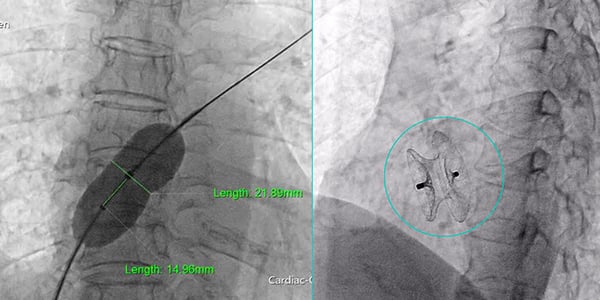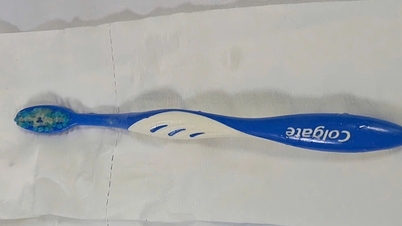Ms. PTB (66 years old, living in Da Nang) was admitted to the Family Hospital for emergency care due to difficulty breathing when exerting herself, palpitations, and severe pain in her left chest. When the doctor examined her, he discovered that her heart was completely arrhythmic.

The hole size is 22cm through the results of cardiac catheterization under fluoroscopy and the image after intervention to close the hole with an umbrella device.
Given the patient's urgent condition, the doctors immediately held a multidisciplinary consultation to agree on the optimal treatment plan. The team decided to perform a procedure to close the atrial septal defect using a percutaneous instrument. The patient underwent a thorough echocardiogram to accurately determine the size and structure around the edge of the defect, thereby selecting the most appropriate device to close the defect.
Dr. Ung Nho Thuong, Cardiovascular Stroke Intervention Unit, Family Hospital said that atrial septal defect is one of the common congenital heart defects in adults, occurring when there is a hole in the septum between the right atrium and the left atrium.
Currently, transcatheter atrial septal defect closure is the first choice because the minimally invasive method brings many benefits to patients such as: no need for anesthesia, only local anesthesia in the groin area; short operation time, only about 1-2 hours; fast recovery time, patients can be discharged after 1-2 days. In particular, the heart is restored without leaving any surgical scars on the chest.

Mrs. B was happy because the doctors intervened promptly and her health is now stable.
After the intervention, the patient was awake and able to communicate with the doctor because he did not need anesthesia at all. His heart rate and blood pressure were stable, he had no chest pain or difficulty breathing. The ultrasound results showed that the device to close the hole was in the correct position, adhered well to the edges, did not affect the heart valve, and there was no longer blood flow between the left and right atriums as before. The patient's health improved and he was discharged two days later.
Atrial septal defect is a common congenital heart disease, accounting for 5-10% of congenital heart defects in children, and 30% in adults, accounting for about 0.01% of the total population. If not detected promptly, it can become dangerous due to complications such as heart failure, arrhythmia, stroke, etc.
Therefore, MSc. Resident Doctor Nguyen The Thiet, Department of Stroke Emergency Resuscitation, Family Hospital recommends: When there are symptoms such as difficulty breathing during exertion, coughing, anxiety, arrhythmia, or symptoms of hemiplegia... people should quickly go to reputable medical facilities for timely examination and treatment, to avoid dangerous complications.
Source: https://doanhnghiepvn.vn/tin-tuc/da-nang-dung-dung-cu-qua-da-kip-thoi-bit-lo-thong-lien-nhi-cho-benh-nhan-tim-bam-sinh/20250415105609156


![[Photo] Chinese, Lao, and Cambodian troops participate in the parade to celebrate the 50th anniversary of the Liberation of the South and National Reunification Day](https://vphoto.vietnam.vn/thumb/1200x675/vietnam/resource/IMAGE/2025/4/30/30d2204b414549cfb5dc784544a72dee)
![[Photo] Flag-raising ceremony to celebrate the 50th anniversary of the Liberation of the South and National Reunification Day](https://vphoto.vietnam.vn/thumb/1200x675/vietnam/resource/IMAGE/2025/4/30/175646f225ff40b7ad24aa6c1517e378)

![[Photo] Performance of the Air Force Squadron at the 50th Anniversary of the Liberation of the South and National Reunification Day](https://vphoto.vietnam.vn/thumb/1200x675/vietnam/resource/IMAGE/2025/4/30/cb781ed625fc4774bb82982d31bead1e)





















































































Comment (0)